
Back pain is, unfortunately, a very common complaint. And for many of us, the discomfort of back pain can persist well into the night, even disrupting sleep. But just because back pain is considered fairly normal doesn’t mean you have to grin and bear it.
One of the simplest things you can do is start implementing some bedtime stretches for back pain. We spoke with a few experts to better understand what causes back pain and how to design an effective nighttime stretch routine to reduce discomfort — and help you sleep better, too.
Note: The content on Sleepopolis is meant to be informative in nature, but it shouldn’t be taken as medical advice, and it shouldn’t take the place of medical advice and supervision from a trained professional. If you feel you may be suffering from any sleep disorder or medical condition, please see your healthcare provider immediately.
Long Story Short
- Back pain is very common, with an estimated 60-80 percent of adults in the United States likely to experience it at some point. (1)
- Strengthening the core and back muscles can help alleviate back pain and prevent future soreness. (1)
- One way to do this is by implementing more strategic stretching into your daily routine to engage these muscles.
- Many people find that a nighttime stretching routine can help.
What Causes Back Pain?
There are over 30 muscles located in the back, each contributing to your movement, balance, and posture. These muscles work together to support your spine and facilitate various upper-body movements. (2) When one or more of these muscles gets tweaked, injured, or overused, the resulting pain can be a real drag. So what causes back pain, anyway?
Vivek Babaria, D.O., board-certified interventional spine & sports medicine physician at DISC Sports & Spine Center, says the most common culprits of back pain he sees in his practice include:
- Strains, often due to heavy lifting, car accidents, or even the sudden awkward moments we’ve all experienced as part of our day (like jolting your body in a weird way to pick something up from the floor)
- Herniated or bulging discs
- Arthritis, particularly osteoarthritis, which can affect the lower back and lumbar joints
- Skeletal irregularities, such as scoliosis (abnormal curving of the spine)
- Osteoporosis, a condition of porous bones that can increase your risk of fractures
- Poor posture when sitting and standing, which can put a strain on your muscles and ligaments and cause pain
- Sacroiliac joint pain, which can cause pain in your lower back
Dr. Thomas Pontinen, M.D., LCP-C from Midwest Anesthesia and Pain Specialists agrees, saying that sprains or strains are to blame for most instances of back pain, but he also sees patients managing pain from car accidents, slips and falls, degenerative disc disease, arthritis, or overexertion. (3)
Another important factor that isn’t uncommon to see is when individuals are carrying extra body weight, which can put further stress on the back and joints and worsen pain. (4) Overall, Pontinen says, “If the body can’t process daily activity or exertion effectively, the joints in the back can pick up a lot of stress, and they’ll start to hurt.”
In other words, there are so many possible causes of back pain that you may have trouble pinpointing the cause(s). While getting to the root of the problem is important, especially if you have ongoing back pain, the most immediate thing you can do is find ways to alleviate it — like nighttime stretching.
Nighttime Stretching Routine for Back Pain
If you’ve ever tried to sleep with back pain that just won’t quit, you know how challenging it can be to find a comfortable position to relax and fall asleep in, let alone stay asleep all night. So what can you do?
Darcie Pervier, MSPT, PES and Owner of Newburyport Wellness, LLC says, “It’s so important to address bedtime back pain if it is disrupting your rest because sleep is such a vital pillar of health. Often, it doesn’t take much to reduce your pain and get a good night’s sleep.”
She says most of us are simply sitting too much and not getting enough variety in how we move our bodies during the day. In addition to finding a comfortable sleeping position that doesn’t further strain your back muscles, Pervier says intentional stretching can help.
Research shows that even people with nonspecific low back pain (meaning, it just hurts and they don’t know why) benefit from doing core stabilization exercises. (5)(6) One study even found that core stabilization exercises were more effective in reducing back pain than strengthening exercises. (7)
If you’re in the market for some nighttime stretching, Babaria offers the following 10 exercises to help you create a bedtime routine, which he often prescribes to his clients. If you don’t have time for all of them, choose a few to do each night within the hour before you lie down. These are designed to particularly engage your back and abdominal muscles to help stabilize and strengthen them. (8)
Keep in mind that some of these may be better suited for your daily workout routine versus your nighttime preparation for bed. While this isn’t true for everyone, we’ve divided the following exercises into those to try during exercise and those to try before you lie down at night. If you experience any pain or discomfort during any of these exercises, consult your doctor before continuing them.
Best For Before Bed
1. Head Rolls

Head rolls can be done at any time of the day, like when you’re sitting at your desk or at the table for dinner. You might also do a few before you lie down for bed to help stretch out your neck and upper back muscles. Aim to do three sets of three head rolls on each side.
To perform them, keep your shoulders relaxed and follow these steps:
- Sit in a chair or stand with your weight evenly distributed on both feet.
- Gently bring your chin toward your chest.
- Roll your head to the right and turn so that your ear is over your shoulder. Hold for 5 seconds.
- Gently roll your head back toward your chest and to the left. Turn your head so that your ear is over your left shoulder. Hold for 5 seconds.
- Slowly roll your head back and in a clockwise circle three times.
- Reverse directions and slowly roll your head in a counterclockwise circle three times.
2. Kneeling Back Extension
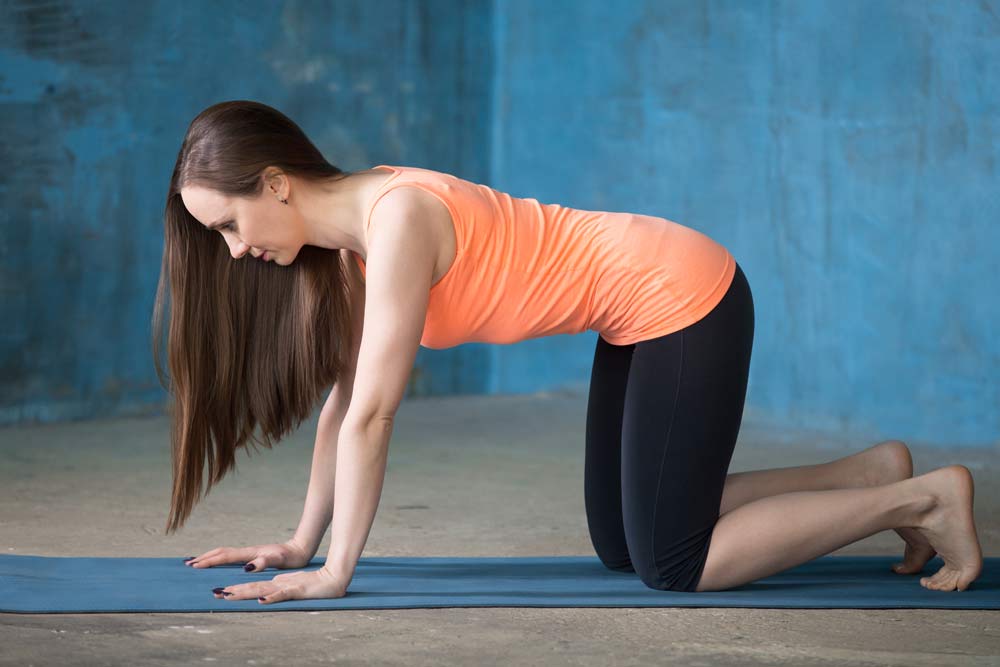
This stretch should be done with all four limbs on the floor, preferably in a carpeted area or on a soft mat to prevent knee pain. This is a great stretch to perform daily, anywhere from 3-10 times.
Here’s how to do it:
- Start in a table-top position on your hands and knees with your hands positioned evenly under your shoulders.
- Rock forward onto your arms, round your shoulders, and allow your lower back to drop toward the floor. Hold for 5 seconds.
- Rock backward and sit your buttocks as close to your heels as possible (also known as a child’s pose).
- Extend your arms and hold for 5 seconds.
3. Sitting Rotation Stretch
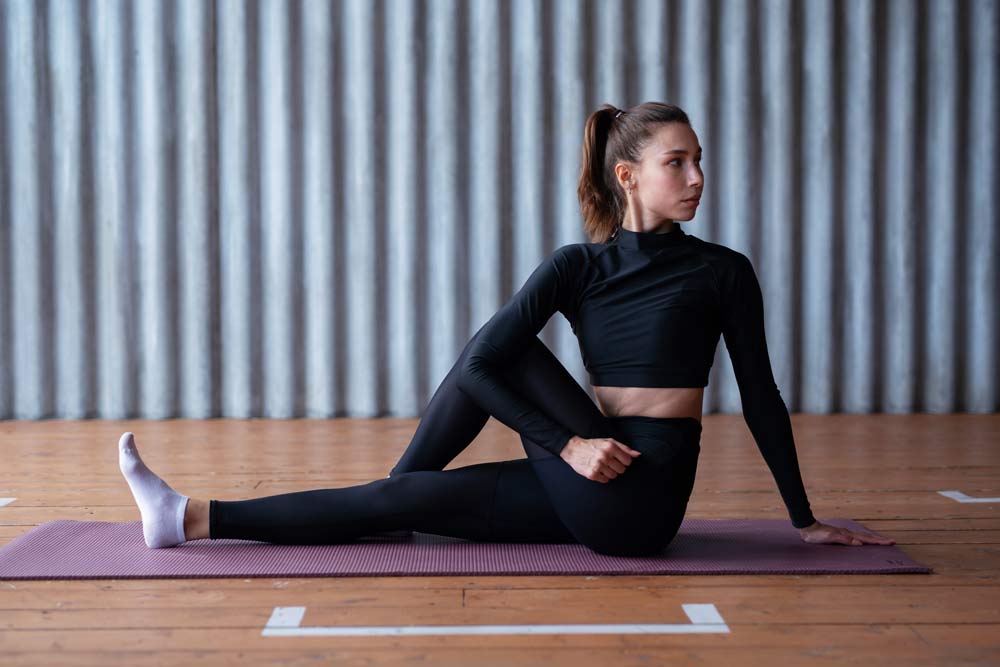
This movement stretches your lower back, side muscles, and buttocks, and feels great on the spine. Try to do it nightly, performing 2-4 sets on each side.
Follow these steps:
- Sit on the floor with both of your legs straight out in front of you.
- Cross one leg over the other, so that your foot is planted on the ground and your knee is bent in front of you.
- Slowly twist toward the outside of your bent leg, putting the hand on that side behind you for support.
- Place your opposite arm on the side of your bent thigh (on your quadricep muscle) and use it to help you twist further, but gently.
- Look over your shoulder and hold the stretch for 30 seconds. Slowly come back to the center and repeat the movement on the other side.
4. Modified Seat Side Straddle
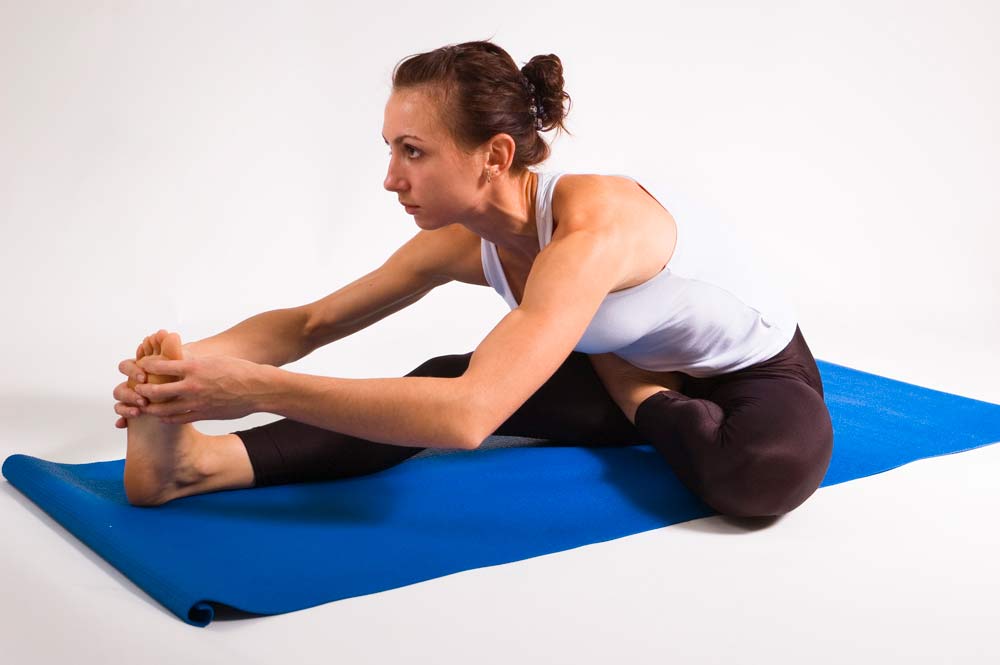
You’ll be able to really feel this stretch in your hamstrings and inner thigh muscles, but it’s also beneficial for stretching out your lower and mid back.
Here’s how to do it, ideally on the floor before getting into bed:
- Sit on the floor with one leg extended outward to the side and the other leg bent toward you.
- Keep your back as straight as you can while bending from your hips toward the foot of your straightened leg. Reach your hands toward your toes and hold for 5 seconds. (It’s okay if you can’t reach your toe; just reach as far as you can without bending your leg).
- Slowly round your spine and bring your hands to your shin or ankle.
- Bring your head down as close to your knee as possible.
- Hold for 30 seconds and then relax for 30 seconds.
- Repeat on the other side and continue to switch between sides for 4-10 reps.
5. Knee to Chest
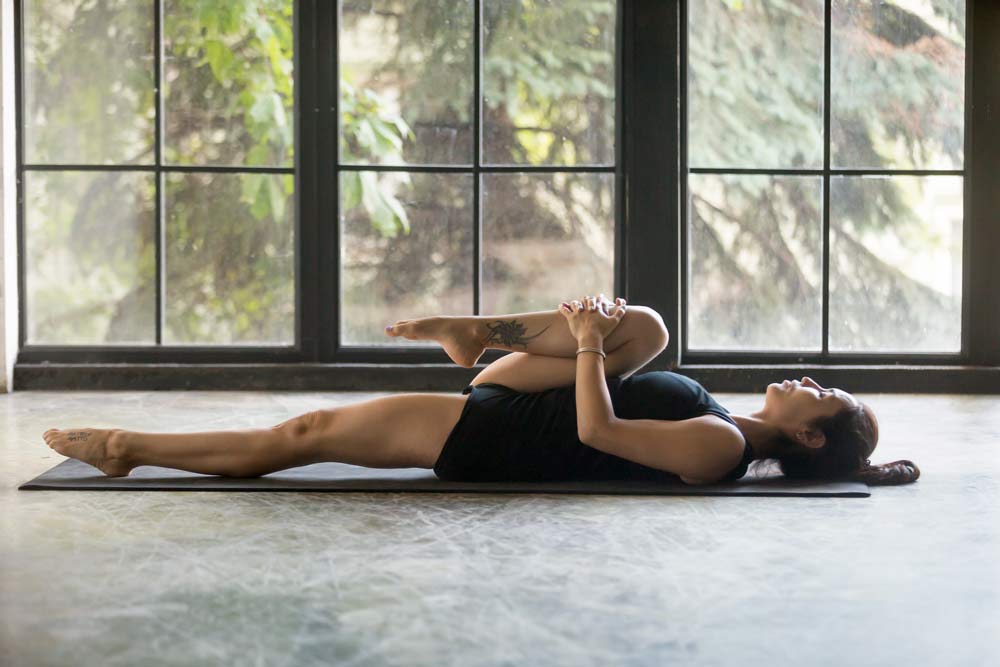
Before crawling into bed, try this stretch, which can be performed on the carpet. It stretches your lower back, inner thigh, and hip.
Follow these steps and aim for 6-10 reps of the full sequence:
- Lie on your back on a comfortable floor that feels gentle on your spine, with your neck relaxed and your head touching the ground.
- Lift one leg and bring your knee toward your chest. Grasp your knee or shin and pull your leg in as far as it will go.
- Tighten your core muscles and press your spine to the floor, trying to minimize any space between your back and the ground. Hold for 5 seconds.
- Repeat on the other side, then pull both legs in together.
Best For Your Exercise Routine
6. Bird Dog

Named after the position hunting dogs take when they spot prey, the bird dog is a movement meant to stretch your lower back and buttocks, but can also engage the core muscles.
Here’s how to perform it:
- Start on the floor in a tabletop position, with your hands directly under your shoulders and your hips over your knees.
- Tighten your abdominal muscles and raise one arm straight out to shoulder height and level with your body. Hold until you feel balanced.
- Slowly lift and extend the opposite leg straight out from your hip. (If your left arm is extended, extend your right leg, and vice versa).
- Tighten the muscles in your buttocks and thigh, and hold this position for 15 seconds.
- Slowly return to the start position and repeat with the opposite arm and leg, switching between sides 5 times.
7. Plank

While the plank is a popular movement to increase core strength, it’s also a great way to stretch and stabilize your back muscles and buttocks before getting into your bed. (9) You might choose to hold one longer plank (say, 60-90 seconds) or repeat a few shorter planks with a goal of 30 seconds each.
Here’s how to do a plank position correctly:
- Lie on your stomach with your forearms on the floor and your elbows directly below your shoulders.
- Tighten your abdominal muscles and lift your hips off of the floor.
- Squeeze your gluteal muscles and lift your knees off of the floor.
- Keep your body straight and hold for your allotted time goal. You can modify it by returning your knees to the floor and holding with just your hips lifted. You could also go to a high plank position, resting on your palms instead of your forearms.
- Slowly return to the start position and rest for 30 seconds before repeating.
8. Modified Side Plank
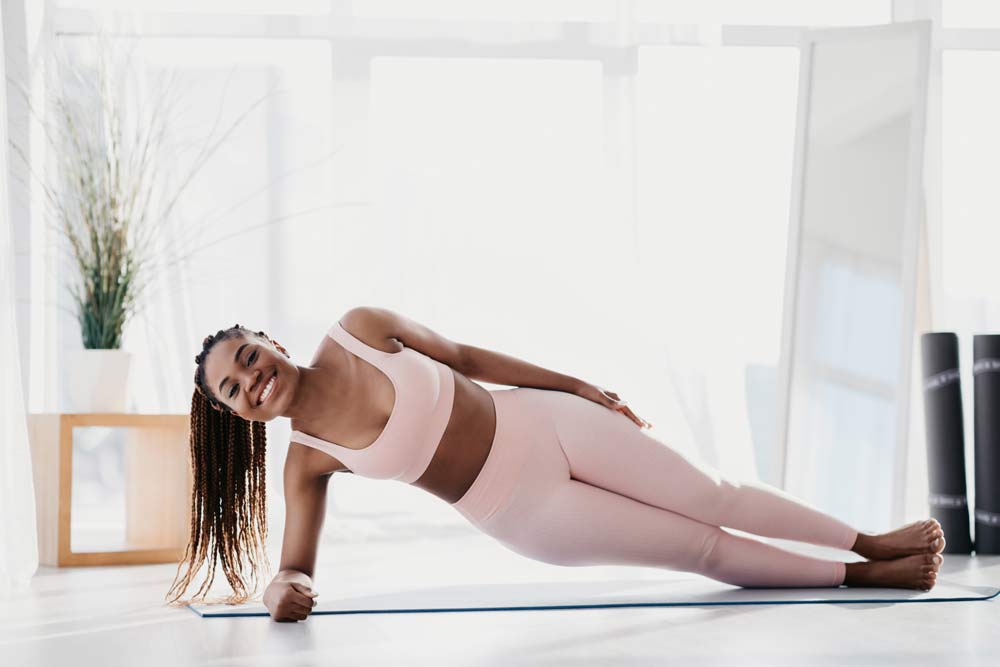
This side plank engages your waist, lower back, and core muscles. They’re great to do before or after your standard plank since you’re already in this position. Aim for 3-5 repetitions on each side.
Here’s how to do modified side planks:
- Lie on your side on the floor with your bottom leg slightly bent and your top leg straight. Your elbow should be directly under your shoulder with your forearm extended on the floor in front of you.
- Tighten your abdominal muscles and raise your hip off of the floor.
- If you can, straighten your bottom leg and lift your knee off of the floor.
- Keep your body straight and hold this position for 15 seconds.
- Slowly return to the start position and repeat on the other side.
9. Hip Bridge
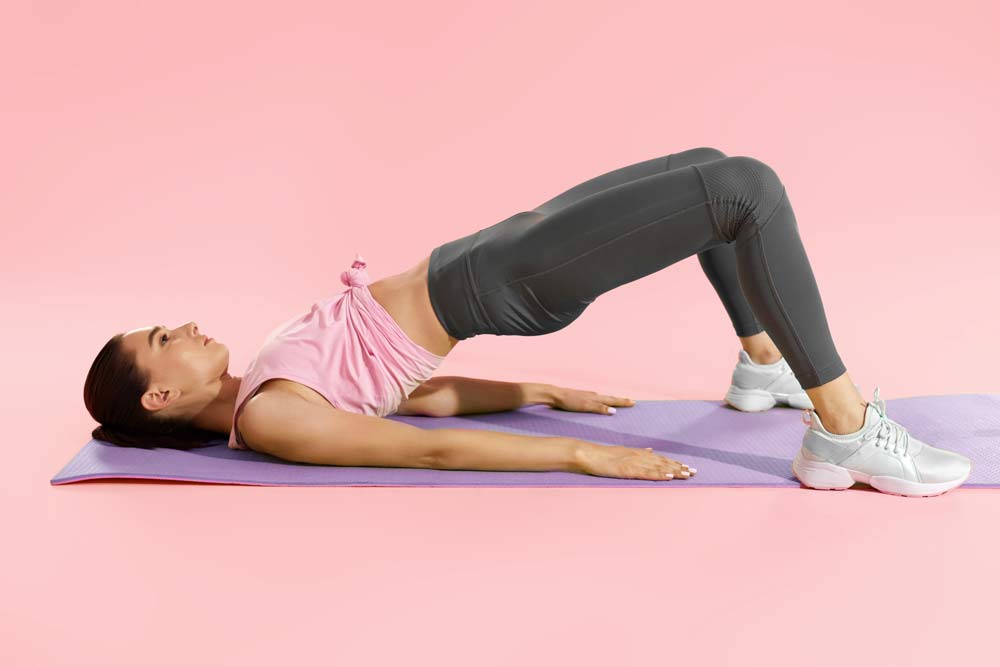
Also called a glute bridge, a hip bridge works your buttocks but is felt in your thighs and lower back too, which can help stretch and strengthen these muscles before you lie down for bedtime. Try to do at least five per day.
To perform a hip bridge, follow these simple steps:
- Lie on your back on the floor with your arms at your sides, your knees bent, and your feet flat on the floor. Keep your head on the ground and relax your neck.
- Tighten your abdominal and gluteal muscles and lift your pelvis so your body is in a straight line from your shoulders to your knees.
- Hold this position for 15 seconds.
- Slowly return to the start position and repeat.
10. Abdominal Crunches
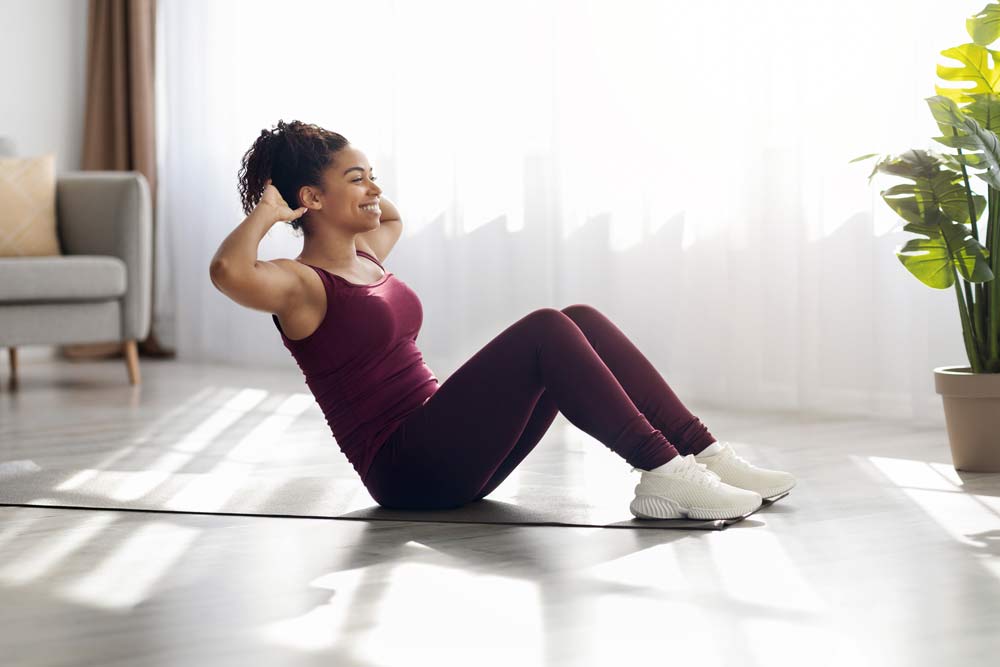
Crunches aren’t just to build a six-pack — they help strengthen your core and back, which can help alleviate pesky back pain. As you might expect, you’ll primarily feel this movement in your abdominal muscles.
Here’s how to do a simple crunch exercise to support your back:
- Lie on your back on a comfortable floor with your knees bent, feet on the ground, and hands at the back of your head with your elbows open wide out to your sides.
- Tighten your abdominal muscles and lift your head and shoulder blades off of the floor.
- Relax your head into your hands, keep your lower back flat on the floor, and hold for 2 seconds. The crunch should be powered by your ab muscles, not by pulling on your neck.
- Slowly lower and repeat for 2-3 sets of 10.
Back Stretches in Bed
Some nighttime stretches can be done when you’re already in bed if that’s your preference. Here are a few lower back stretches in bed to loosen your back muscles in preparation for sleep (or when waking up) to help minimize back pain.
Cat-Cow
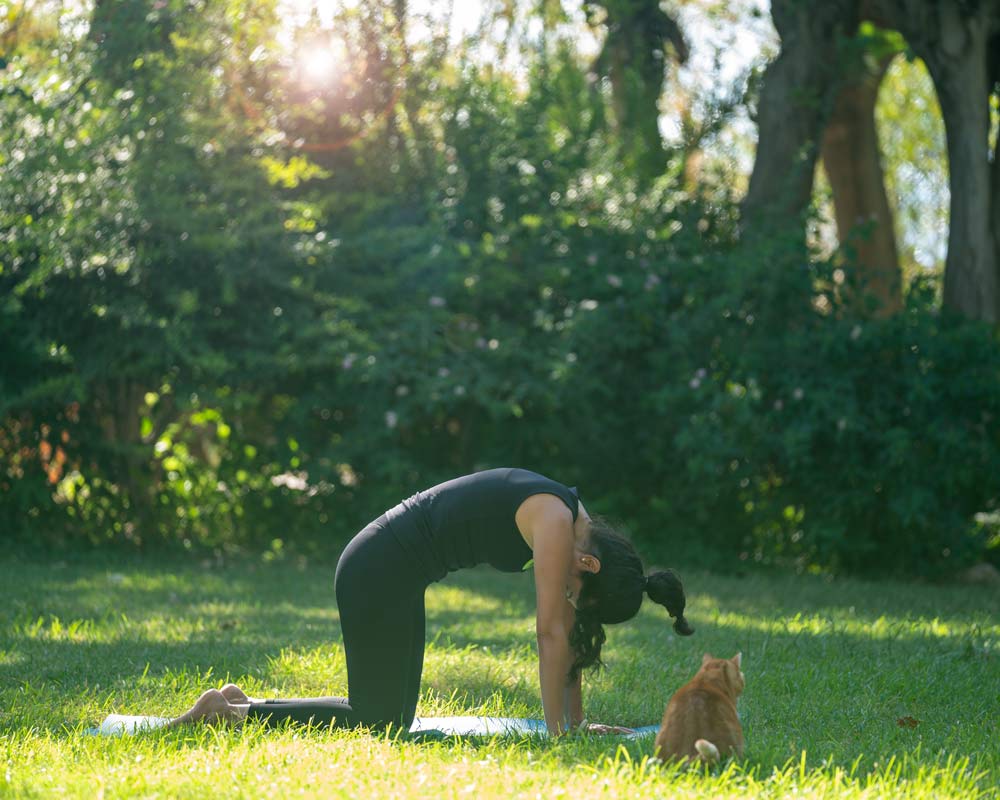
Doing this exercise before bed can help stretch and relax your back muscles, reducing tension and potentially easing pain for a more restful sleep. Pervier says, “I love cat cows with a modification of not only rolling up and down from the top of your back but also completing the exercise by initiating the movements from the pelvis.”
Here’s how to do it:
- Get in a tabletop position on your bed, with your hands directly under your shoulders and your knees under your hips. Keep your spine in a neutral position.
- As you inhale, round your back towards the ceiling into a cat pose. Tuck your chin towards your chest and pull your belly button towards your spine. This position should create a gentle arch in your upper back, mimicking the curve of a cat stretching.
- As you exhale, reverse the movement into a cow pose. Drop your belly towards the mattress and lift your chest and tailbone towards the ceiling. Let your head drop naturally or lift slightly to gaze forward, creating a gentle arch in your lower back.
- Flow between the two poses, coordinating your breath with each movement.
- Repeat the sequence for 1-2 minutes, moving slowly and gently to avoid straining your back.
Pelvic Tilts
This exercise helps to strengthen the abdominal muscles and support the lower back, potentially reducing pain and improving overall back comfort.
Here’s how to do them:
- Lie on your back on the bed with your knees bent and feet flat on the mattress. Your arms can rest at your sides or be placed gently on your stomach.
- Engage your core muscles gently. Tilt your pelvis backward by pressing the lower back into the mattress. This movement should flatten the natural curve in your lower back. You should feel a slight tightening in your lower abdomen.
- Hold this position for 5-10 seconds while continuing to breathe deeply and steadily. Ensure you’re not holding your breath and keep your shoulders relaxed.
- Slowly release the tilt and return to the starting position, allowing the natural curve in your lower back to return.
- Perform the pelvic tilt exercise for 10-15 repetitions. Repeat this 2-3 times to stretch and strengthen your lower back.
Child’s Pose
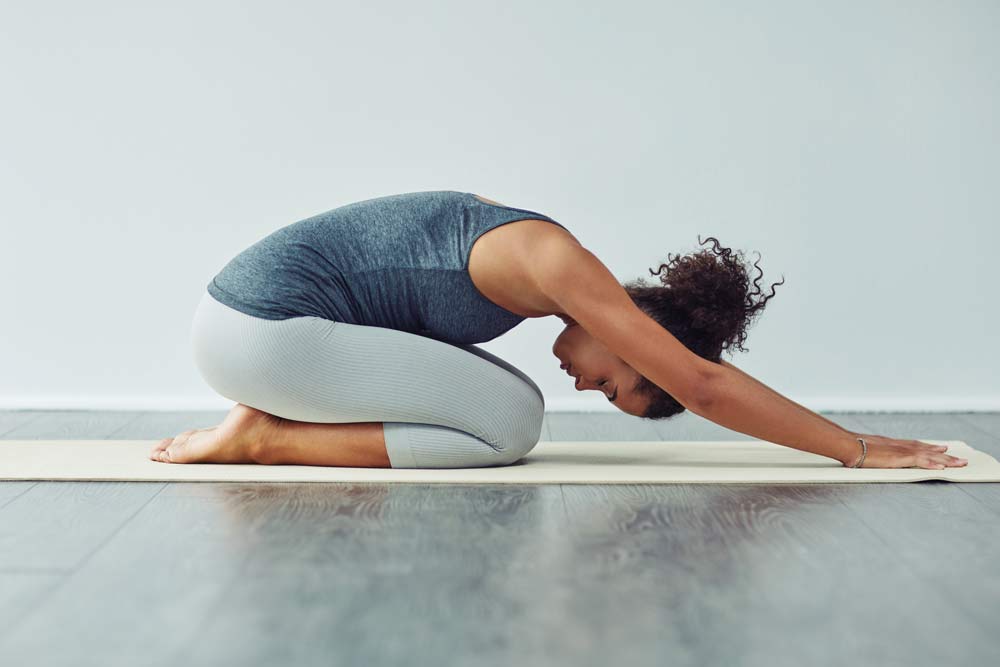
If someone has a healthy spine, Pervier recommends including a child’s pose in their nightly routine, with the added movement of reaching the arms to the left and right with some deep breathing to expand the ribs. This is a restorative yoga pose that can help stretch your back, side muscles, hips, and thighs.
Here’s how to do them in your bed:
- Begin by kneeling on the bed with your knees about hip-width apart. Sit back on your heels, and then gently fold forward.
- Stretch your arms forward on the bed, allowing your forehead to rest on the mattress. If reaching forward is uncomfortable, you can also place your arms by your sides with your palms facing up.
- Allow your back to relax and sink into the stretch. Feel the gentle elongation of your spine and the release of tension in your lower back, shoulders, and hips.
- Take slow, deep breaths, allowing your abdomen to expand with each inhale and contract with each exhale. This helps to deepen the stretch and enhance relaxation.
- Remain in child’s pose for 1-3 minutes or as long as feels comfortable. Focus on maintaining a relaxed and steady breathing pattern.
- To come out of the pose, gently lift your torso and return to a seated position or shift to lying on your back if that feels more comfortable.
Basic Stretching Tips
Stretching is a great way to loosen, relax, and protect your body from pain and injury. However, it’s also important to approach stretching mindfully so as not to put more stress on your joints and muscles.
Here are some tips for effective stretching as you develop your nighttime routine: (10)(11)
- Hold each stretch for 15 to 30 seconds as able.
- Repeat each stretch 2-3 times to improve flexibility over time.
- Stretch one side of the body at a time to focus on specific muscle groups.
- Avoid bouncing or jerking movements, instead using slow, controlled motions.
- Stretch only to the point when you feel mild tension, not pain, to prevent injury.
- Breathe deeply and naturally while stretching to help relax your muscles.
- Try to include stretching into your daily routine for consistent flexibility gains.
FAQs
What stretches can I do for lower back pain?
To help alleviate lower back pain, try the cat-cow stretch by alternating between arching and rounding your back while on all fours. Child’s pose, where you sit back on your heels with arms extended forward, also gently stretches the lower back. Finally, the knee-to-chest stretch, where you pull one knee at a time toward your chest while lying on your back, can help release tension.
Should you stretch as soon as you wake up?
Barbiak encourages stretching when you wake up, saying it helps with flexibility and blood flow, reduces stiffness, and helps prevent unexpected injuries among active people. (12) Pontinen agrees, saying that stretching can help reduce stiffness that builds up overnight.
The Last Word From Sleepopolis
We’ve all been victims of back pain from time to time, but when it becomes disruptive to your life, it’s important to take action. Adding a nighttime stretching routine can help alleviate discomfort and strengthen your back and core muscles to help prevent further injuries and strains. If you continue to experience back pain, it’s always a good idea to speak with your healthcare provider to identify the root cause(s) and see what other interventions may help.
- Paolucci T, Attanasi C, Cecchini W, Marazzi A, Capobianco SV, Santilli V. Chronic low back pain and postural rehabilitation exercise: a literature review. J Pain Res. 2018;12:95-107. Published 2018 Dec 20. doi:10.2147/JPR.S171729
- Henson B, Kadiyala B, Edens MA. Anatomy, Back, Muscles. [Updated 2023 Aug 14]. In: StatPearls [Internet]. Treasure Island (FL): StatPearls Publishing; 2024 Jan-. Available from: https://www.ncbi.nlm.nih.gov/books/NBK537074/
- Nolet PS, Kristman VL, Côté P, Carroll LJ, Cassidy JD. The association between a lifetime history of low back injury in a motor vehicle collision and future low back pain: a population-based cohort study. Eur Spine J. 2018;27(1):136-144. doi:10.1007/s00586-017-5090-y
- Guan J, Liu T, Gao G, Yang K, Liang H. Associations between lifestyle-related risk factors and back pain: a systematic review and meta-analysis of Mendelian randomization studies. BMC Musculoskelet Disord. 2024;25(1):612. Published 2024 Aug 1. doi:10.1186/s12891-024-07727-0
- Smrcina Z, Woelfel S, Burcal C. A Systematic Review of the Effectiveness of Core Stability Exercises in Patients with Non-Specific Low Back Pain. Int J Sports Phys Ther. 2022;17(5):766-774. Published 2022 Aug 1. doi:10.26603/001c.37251
- Frizziero, A., Pellizzon, G., Vittadini, F., Bigliardi, D., & Costantino, C. (2021). Efficacy of Core Stability in Non-Specific Chronic Low Back Pain. Journal of Functional Morphology and Kinesiology, 6(2), 37. https://doi.org/10.3390/jfmk6020037
- Hlaing SS, Puntumetakul R, Khine EE, Boucaut R. Effects of core stabilization exercise and strengthening exercise on proprioception, balance, muscle thickness and pain related outcomes in patients with subacute nonspecific low back pain: a randomized controlled trial. BMC Musculoskelet Disord. 2021;22(1):998. Published 2021 Nov 30. doi:10.1186/s12891-021-04858-6
- Fernández-Rodríguez R, Álvarez-Bueno C, Cavero-Redondo I, et al. Best Exercise Options for Reducing Pain and Disability in Adults With Chronic Low Back Pain: Pilates, Strength, Core-Based, and Mind-Body. A Network Meta-analysis. J Orthop Sports Phys Ther. 2022;52(8):505-521. doi:10.2519/jospt.2022.10671
- Calatayud J, Escriche-Escuder A, Cruz-Montecinos C, et al. Tolerability and Muscle Activity of Core Muscle Exercises in Chronic Low-back Pain. Int J Environ Res Public Health. 2019;16(19):3509. Published 2019 Sep 20. doi:10.3390/ijerph16193509
- Harvard Health Publishing. Six tips for safe stretches. (2019). Retrieved from: https://www.health.harvard.edu/staying-healthy/six-tips-for-safe-stretches
- Harvard Health Publishing. The ideal stretching routine. (2023). Retrieved from: https://www.health.harvard.edu/staying-healthy/the-ideal-stretching-routine
- Takeuchi, K., Nakamura, M., Fukaya, T. et al. Stretching intervention can prevent muscle injuries: a systematic review and meta-analysis. Sport Sci Health (2024). https://doi.org/10.1007/s11332-024-01213-9
Babaria, Vivek. Personal interview. September 4, 2024.
Thomas Pontinen, Thomas. Personal interview. September 4, 2024.
Pervier, Darcie. Personal interview. September 4, 2024.




























